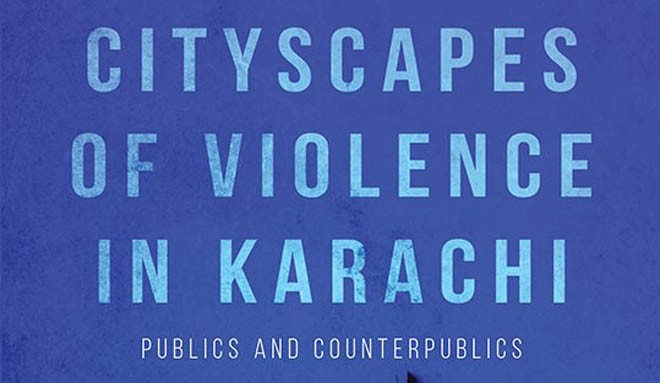
Essays on Karachi that look at how stories of violence are absorbed and retold

Nichola Khan’s ethnographic account of Liaqatabad (Lalukhet), where she lived in the early 1990s with her mohajir ex-husband, becomes progressively darker: kite-flying on rooftops, naan-khatai from the corner bakery, guns buried in the Lyari riverbed, a peeli kotthi whispered to be a former torture house, a policeman’s pregnant wife decapitated inside her home. This last confession, uttered unprompted to the author, haunts the killer - Arshad sees his victim’s face at night, in the trees, he wakes up at night crushed by her ghost - just as it haunts his confidante: "It detached me too from reality," writes Khan, "my head spinning afterwards sometimes, flying from my body, like that woman’s." With this (admittedly slightly clumsy) comparison, she asks: how are stories of violence absorbed and (re)told - and can they be told in a way that leads to a constructive rejection of violence rather than superficial disavowal and lurid fascination?
Many of the essays in Cityscapes of Violence in Karachi: Publics and Counterpublics, edited by Nichola Khan - social anthropologist and author, previously, of Mohajir Militancy in Pakistan: Violence and Transformation in the Karachi Conflict - attempt to answer this question, either directly or indirectly. The voices contained within, to the volume’s credit, are of activists, poets and journalists as well as more academically-inclined ethnographers and political scientists.
Violence, be it spectral or real, has come to define Karachi, it is usually what we talk about when we talk about the city - but how we react to this violence varies. We may "put the pillow on our face" (Zeeshan Sahil); or use the violence we witness as fodder for casual conversation: "hot and fresh for tonight’s dinner," to quote Azra Abbas, whose poetry is examined by Asif Farrukhi in the volume’s opening essay. We may channel personal loss into civic activism, as Kausar S. Khan details in a deeply personal account of her reckoning with four ‘ordinary activist deaths’ in 2013. Or we do what the poets do, and turn suffering into art.
One impact of increasing violence in the city is that the space one calls ‘home’ in Karachi has progressively shrunk and become increasingly tied to one’s own ethnically-defined neighbourhood, writes Nida Kirmani in her account of the lived experience of residents of Lyari (which is to the city what the city is to the rest of the country - a site of a gratuitous violence).
But, as Arif Hasan argues in his chapter on the death of cosmopolitanism in Karachi and its nascent revival, the city was not always so starkly segregated along class and ethnic lines.
Could it be that the act itself of remembering peace - of invoking a Karachi without habitual violence - has been permanently compromised, asks Farzana Shaikh, and do we perhaps need to invoke other narrative timelines, wonders Kamran Asdar Ali, in the two afterwords concluding the volume. "The 1980s, always remembered as the dreaded Zia era, is also the decade when the Orangi Pilot Project was initiated in Karachi, when left-wing activists started theatre groups such as Dastak, when the women’s movement Tehreek-e-Niswan and the Women’s Action Forum organised activities in the city, and the centenary of Karl Marx’s death was celebrated at the Karachi Press Club. Such renditions are also valid histories."
The Muttahida Quami Movement (MQM) looms large over the book of essays, perhaps predictably so. Nichola Khan’s ethnography of Liaqatabad and its militants in the 1990s is complemented by Laurent Gayer’s profile, circa 2013, of a reluctant part-time militant who joins the party primarily for social mobility - prior to this, he was learning Japanese and toying with the idea of moving to Japan to start a new life.
Both of these accounts shed light on what it means to be a young and male and searching for purpose in Karachi - as does Oskar Verkaaik’s exploration of mohajir support for the MQM and the Dawaat-e-Islami, a proselytising movement that denounces politics and promotes Islam as the antidote to ethnic strife. "With travel becoming more difficult and costly, and the MQM under siege by state forces and plagued by internal violence," religion presented itself as an alternative to outmigration and politics.
Verkaik cites a young muhajir man, Bilal, who availed this option. In his view, the term muhajir had been wrongly ethnicised by the MQM; indeed, his membership in the Dawat-e-Islami allowed Bilal to truly become a muhajir in the spiritual sense of the word, by cultivating piety. This attempt to redefine muhajir is also present in journalist Zia Ur Rehman’s account of Karachi as a city where Pashtuns are poised to become the single largest ethnic group in the coming decades. "Karachi’s Mohajirs and Pashtuns certainly share commonalities," he writes. "Both groups originally migrated from their home towns for a better life, many without any intention of return … by drawing on and sharing in each other’s potential, initiating joint business, and most importantly participating in non-ethnically based party politics, the two communities may yet forge a more peaceful urban environment."
Cityscapes of Violence could have benefited from more rigorous proofreading and fact-checking - Benazir was assassinated in Rawalpindi, not Karachi, for instance, and widely varied estimates of Karachi’s population are uncritically cited - but this doesn’t take away from the variety of thoughtful perspectives contained within.
"If we cannot see a clear solution to end violence," writes Kausar S. Khan, "we hope that along our journey against violence, the way will appear." The volume is no doubt an important contribution in furthering conversation about a dynamic, if troubled, metropolis.